
Experimenting with the labyrinth from Bayeux Cathedral suggests we can approach this pattern not so much as a deviation from the Medieval Labyrinth type (as exemplified in purest form by the Chartres Labyrinth), but rather as a hybrid form linking the labyrinth ‘families’ of Classical and Medieval. This article examines the often-overlooked Bayeux pattern from this perspective.
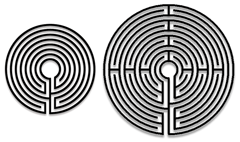
We can characterise the Classical Labyrinth as having
- a single axis,
- unbroken 360° sweeps of motion around its circuits, and
- in its commonest form, seven circuits like tree-rings between start and centre.
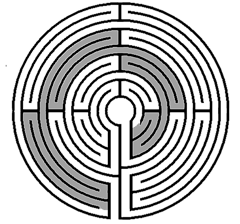
In contrast, the Medieval Labyrinth (after the family categorisation of Jeff Saward (Saward, 2003, 28-31) can be characterised as having:
- four axes at the compass points, embossing the pattern with a cruciform motif and creating quartered sectors like four slices of pie,
- a path which does not require you to fully traverse your current sector, before entering the next,
- a ‘cascade’ effect [1] creating a hidden inner spiral which zig-zags between the peripheral and centre-most circuits (illustrated in Figure 2 for the Chartres Labyrinth), and
- usually, among the French pavement Medievals, eleven circuits.
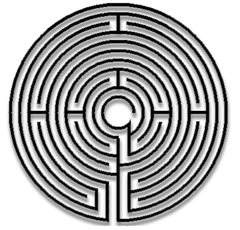
Immediately, the Bayeux Labyrinth (Figure 3) fails twice in the Medieval tick-list. For while it does have four axes and a path gliding between sectors non-sequentially, it doesn’t contain a cascade, and is ten circuits in size.
I have not visited Bayeux, and am unsure if the labyrinth’s design feature of ten circuits was dictated by physical constraints; the pattern is certainly modest at 3.8m diameter (Kern, 2001, 151), but floor plans of the chapter house where it is located would seem to suggest a larger (eleven circuit) pattern might have been accommodated there. Whatever caused the Bayeux Labyrinth’s final form (physical constraints, a quirk of its architects, an only-partial understanding of the ‘pure’ internal symmetry possible in contemporary labyrinth patterns such as Chartres, or even a perceived improvement upon the Chartres pattern [2]), we shall take the Bayeux pattern as it stands to examine the thinking suggested in its design.

First, the issue of cascades. In Figure 4 are compression diagrams of the labyrinths of Chartres and Bayeux. (Note: the labyrinth entrance in each diagram is shown bottom right, and the entrance to the centre is top left. For Bayeux’s centre-hugging circuit, arrows describe the unusual jump between circuits across the South axis.)
Chartres’ reflective symmetry is soon felt when you follow the path through the compression diagram. The pattern is built around the cascade (highlighted in grey) that runs diagonally from centre to periphery, and any remaining space in the compression diagram cleverly mirrors across this cascade-axis, with a 180° flip.
By contrast there is no cascade in the Bayeux diagram. Instead, we are struck by its four circuits which each take us along highly unusual (amongst the Medieval Family) unbroken circuits of 360° motion. (Contrast this against the Chartres diagram, where all eleven circuits have flow redirected by the four axes.)
More striking still in the Bayeux Labyrinth is the seeming lack of reflective symmetry – yet symmetry does exist within the Bayeux Labyrinth. To see it, let’s consider the origins of the cascade itself.
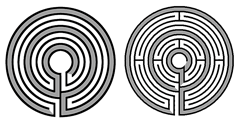
We are most familiar with cascades from their sophisticated expression in the Chartres Labyrinth (cf. Figure 2) - but this cascading motion is in fact a layered echo from the Classical Labyrinth. As depicted in Figure 5, note how in the Classical Labyrinth one smooth movement takes us from peripheral circuit to innermost. Illustrated as a black path, this motion forms a single zig-zagging unit around the Classical Labyrinth’s single axis (which runs South). (Incidentally, it is this zig-zag unit that is the building block used by Chartres, to create its own complex cascade, stacking and duplicating the unit about four axes.) In Figure 5, if we now look at the Bayeux Labyrinth, we find there is a cascade after all - the same simple cascade we met in the Classical.
At least, in the outermost five circuits we find this. For whatever reason, the single zig-zag cascade is incomplete in the Bayeux pattern. In the innermost five circuits, however, can be read a desire to complete the single cascade unit offered by the Classic. The evidence for this is the 360° full-sweep around the centre of the Bayeux Labyrinth, a circuit patently ‘tagged onto’ the pattern - and whose presence makes no sense, unless it is to ape the final element of the single cascade unit (the innermost circular pathway, as seen in the seven-circuit Classical).
So, there is an incomplete, single cascade in the Bayeux. But this still remains a very asymmetrical labyrinth, making it a peculiarity within the symmetrically-meticulous Medieval Family.
Let’s now look at the flaws in its symmetry, overall.
These occur in the Bayeux Labyrinth around the South axis. To understand how perfect symmetry looks, in Figure 6 we have a slice of the Chartres Labyrinth - the area around the South axis. It’s in this area that the inner symmetry becomes clear. The lower ‘quadrants’ which flank the South axis (called A and D), are mirrored in the upper quadrants (called B and C). A mirrors D. A also mirrors B. Thus with Chartres, we have harmonious symmetry.
But Chartres has eleven circuits to construct this symmetry inside; Bayeux has just ten. What happens if we grant Bayeux eleven circuits to describe its symmetries? What if those outermost five circuits (that so nicely mirror half of the cascade met in its older cousin, the Classical Labyrinth) are allowed room to reflect themselves in the innermost five circuits?

Look now at the sections extrapolated in Figure 6 for an original Bayeux, and a ‘corrected’ Bayeux.
In the original Bayeux, with our four quadrants that flank the South axis again called A-D, we find the lower quadrants do not mirror the upper ones. Indeed, there is none of Chartres’ ‘A=B=C’ relationship here. In the Bayeux Labyrinth we can’t find any quadrant in A, B, C or D that is identical to another.
But they nearly match. See how B almost mirrors D, and C almost mirrors A. Both upper quadrants strain to reflect their lower counterparts (A matching C, B matching D) but as drawn with a circuit less to play with. It’s as if B and C are shoe-horned in to fit the ten-circuit labyrinth size, and in the process lose the L-shaped circuit that would make them perfect mirrors of A and D respectively.
If we restore this missing circuit, and thus ‘correct’ the quadrants of the Bayeux Labyrinth’s lower axis, A mirrors C, and B mirrors D.
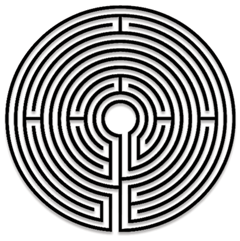
We now have a balanced, harmonious design. Try it; follow the pathway through.
It’s important to note here that our analysis of symmetry in the Bayeux Labyrinth did not need to correct the West, North and East axes. In fact, it would be folly to attempt to; for these are the only positions for the wall placements along those axes to work - if we wish to experience four axis movement inside this labyrinth pattern, whilst keeping the original cascade route we know from the seven circuit Classical Labyrinth.
Or, put more simply, if we wish to marry the Medieval motif of four axis movement with a Classical Labyrinth, this is a good solution to the problem. Rather than being an oddball Medieval, the Bayeux is a logical hybrid of the Classical and Medieval families.
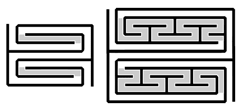
To reinforce this assertion, Figure 8 shows the compression diagrams of the seven-circuit Classical Labyrinth and the corrected Bayeux side by side - and I’d like you to note in each the circuits that are greyed. The two circuits that are greyed in the Classical compression diagram, divide - in the Bayeux – in order to accommodate three circuits each. They split to create room for four axes to emerge (three being the minimum number of circuits you can employ, to permit navigation around multiple axes).
We can therefore describe the corrected Bayeux as a Classical Labyrinth which enlarges two of its circuits to allow multiple axes to sprout inside them; the evolutionary place of Bayeux between the two labyrinth families can now be fully appreciated.
It is, of course, never intended for this to be taken as a chronological argument; Bayeux’s temporal place in the labyrinth 'fossil record' comes long after the emergence of the pattern now commonly called the ‘Chartres’ labyrinth after its most famous installation [3].
Instead, this argument describes the Bayeux Labyrinth as a precursor to the Chartres, in terms of visual logic and design. I imagine its architects looking backwards, rather cleverly, to the original Classical Labyrinth whilst having full awareness of the then-contemporary Chartres model. The Bayeux pattern which we have come to know, with its curious (botched?) layout, was the result of their experimentation - a labyrinth that could offer the multiples axes that the Chartres pattern contained...and the full-circular motion it did not.
Works cited:
- Buchanan, Jim. Labyrinths for the Spirit: How to Create your own Labyrinths for Meditation and Enlightenment. Gaia. 2007.
- Kern, Hermann. Saward, J; Ferré, R (trans). Through the Labyrinth: Designs and Meanings over 5000 Years. Prestel. 2000.
- Saward, Jeff. Labyrinths and Mazes: A Complete Guide to Magical Paths of the World. Gaia. 2003.
Footnotes:
- We could argue that a cascade is not required for a labyrinth that is Medieval; cf. the creation of smaller (seven or nine circuit) Medieval labyrinths as in Buchanan (2007, 78) or Lea Goode-Harris’ Santa Rosa design. But the cascade is so pronounced in the Chartres design it’s hard to consider it a mere side-effect from point 2 in our Medieval characteristics list; the cascade seems the defining feature. The Chartres compression diagram (Figure 4) is ultimately a mapping of the largest possible cascade through four axes, which uses any remaining space to echo the lower axis meanders of the Classical seed pattern. Furthermore, where Medieval family members (e.g. Reims, St Omer) offer only partial cascades through their circuits, the motion still remains distinct enough to be called a modified cascade.

- E.g., in the Bayeux Labyrinth the walls laid along the West and East axes are mirrors of each other, when reflected across the centre space. In the Chartres Labyrinth, the West and East axes are not symmetrical. Perhaps this symmetry made the Bayeux pattern (despite it oddities elsewhere) preferable to the Chartres to its architects. See Figure 9.
- Kern dates it to the end of the 14th Century (Kern, 151) and the earliest occurrence of the Chartrain Labyrinth pattern to the 10th Century (Kern, 112).

